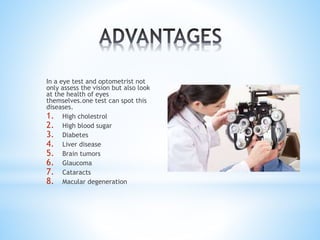The Role of Advanced Diagnostic Equipment in Identifying Eye Disorders
In the world of ophthalmology, the usage of sophisticated diagnostic devices has transformed the early recognition and management of numerous eye conditions. From finding subtle adjustments in the optic nerve to monitoring the progression of retinal conditions, these innovations play a pivotal duty in enhancing the accuracy and efficiency of identifying eye problems. As the need for exact and timely diagnoses continues to expand, the integration of innovative devices like optical comprehensibility tomography and aesthetic area testing has actually become indispensable in the realm of eye treatment. The intricate interaction in between innovation and ocular methods not just drops light on elaborate pathologies however additionally opens doors to tailored treatment methods.
Value of Early Diagnosis
Very early medical diagnosis plays a pivotal function in the efficient administration and therapy of eye problems. Timely recognition of eye problems is crucial as it permits punctual intervention, potentially protecting against more progression of the disease and decreasing long-term complications. By detecting eye disorders at an onset, health care service providers can supply proper therapy strategies customized to the particular problem, ultimately bring about much better end results for people. Moreover, early diagnosis enables clients to gain access to necessary support solutions and sources quicker, boosting their general lifestyle.

Modern Technology for Finding Glaucoma
Sophisticated diagnostic technologies play a vital role in the early detection and monitoring of glaucoma, a leading reason of irreversible blindness worldwide. One more sophisticated device is aesthetic area screening, which maps the sensitivity of a person's aesthetic area, helping to discover any type of areas of vision loss characteristic of glaucoma. These innovative analysis devices make it possible for eye doctors to identify glaucoma in its very early phases, enabling for prompt intervention and better monitoring of the illness to avoid vision loss.
Function of Optical Comprehensibility Tomography

OCT's ability to measure retinal nerve fiber layer thickness permits for specific and objective dimensions, aiding in the very early discovery of glaucoma even investigate this site prior to visual field issues end up being obvious. In general, OCT plays a vital role in enhancing the analysis precision and administration of glaucoma, ultimately contributing to better end results for individuals at danger of vision loss.
Enhancing Diagnosis With Visual Field Screening
A vital part in comprehensive sensory evaluations, visual area testing plays a crucial function in improving the analysis process for different eye conditions. By examining the full degree of an individual's aesthetic field, this examination offers vital information about the functional honesty of the whole visual pathway, from the retina to the aesthetic cortex.
Visual area screening is especially important in the diagnosis and management of conditions such as glaucoma, optic nerve disorders, and various neurological conditions that can influence vision. Via measurable measurements of outer and main vision, clinicians can discover subtle adjustments that may indicate the visibility or development of these conditions, also before visible symptoms occur.
Additionally, aesthetic field testing enables the tracking of therapy efficacy, aiding ophthalmologists tailor healing interventions to individual people. eyecare near me. By tracking changes in aesthetic field performance gradually, healthcare suppliers can make enlightened choices about changing medicines, suggesting surgical interventions, or executing other proper steps to preserve or enhance a client's aesthetic function
Taking Care Of Macular Degeneration

Conclusion
In final thought, progressed analysis tools play a crucial function in determining eye conditions early on. Technologies such as Optical Coherence Tomography and visual field testing have actually considerably improved the precision and effectiveness of detecting problems like glaucoma and macular degeneration.